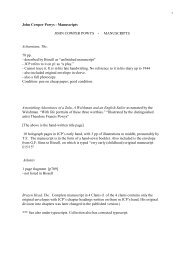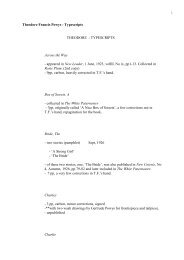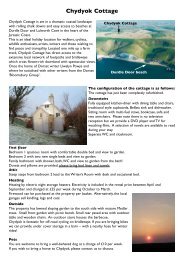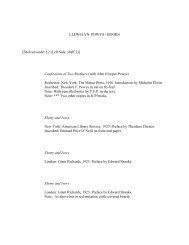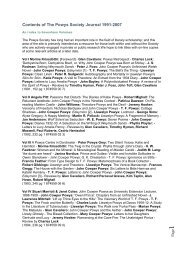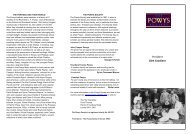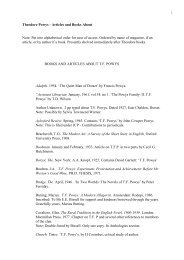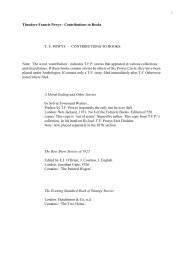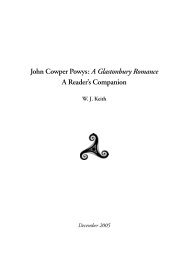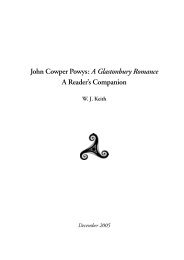J. C. Powys' Autobiography: A Reader's Companion - Site POWYS
J. C. Powys' Autobiography: A Reader's Companion - Site POWYS
J. C. Powys' Autobiography: A Reader's Companion - Site POWYS
You also want an ePaper? Increase the reach of your titles
YUMPU automatically turns print PDFs into web optimized ePapers that Google loves.
44 <strong>Autobiography</strong><br />
an ape or an angel? I, my lord, am on the side of<br />
the angels.”<br />
one of his [Llewelyn’s] books (147) — See The<br />
Verdict of Bridlegoose (112). JCP refers to this<br />
incident again in Letters to Ross (138).<br />
“one thing needful” (334, 424) — Luke 10:42. Also<br />
quoted in Porius (550), Owen Glendower (718),<br />
The Meaning of Culture (55, 238), Dostoievsky<br />
(29), and Rabelais (33).<br />
O’Neill, Bernard [Bernie] (259ff.) — An eccentric<br />
London doctor (1865–1947), a close friend of the<br />
Powys family. Little is known about him. There<br />
are photos in R. P. Graves (Plate 3) and Letters to<br />
Llewelyn (I, between 208 and 209). The anecdote<br />
about his watching a fisherman’s net to see if it<br />
contained a mermaid seems to allude to an<br />
incident parodying Coleridge in Thomas Love<br />
Peacock’s Nightmare Abbey (1818). Llewelyn<br />
called him “this incomparable Irishman” (Skin for<br />
Skin [74]). JCP dedicated Poems, Suspended<br />
Judgments, and Rabelais to him.<br />
open sesame (127) — The password of the forty<br />
thieves in The Arabian Nights Entertainment.<br />
Ophelia ... flowers (31) — The reference is to the<br />
mad Ophelia and the distributing of flowers in<br />
Shakespeare’s Hamlet (IV v).<br />
Orage, Mr. (559) — A. R. Orage (1875–1934),<br />
literary and political editor, who edited the New<br />
Age from 1907 until 1922. Llewelyn was a<br />
contributor. For Llewelyn’s account of what may<br />
have been the same tea-party, see The Verdict of<br />
Bridlegoose (163).<br />
orange-bellied newt[s] (21, 89) — These also<br />
appear in After My Fashion (284), Ducdame (187),<br />
and Wolf Solent (237). Cf. also Llewelyn’s<br />
Impassioned Clay (23).<br />
Orbis Terrarum (592) — The world, the globe<br />
(Latin). From Augustine. See “semper eadem ...”<br />
Orguz, Count (422) — (Powys makes two<br />
mistakes: “Interrment“ should be “Interment”<br />
and “Orguz” should be “Orgaz”.) El Greco’s<br />
painting of the interment is still in the S. Tome<br />
church in Toledo for which it was originally<br />
designed.<br />
Osage hedges (499) — The so-called Osage<br />
orange (Maclura pomifera) of the central United<br />
States is used for hedges. “Osage” refers to an<br />
American Indian people.<br />
Osmaston Park (12, 23) — Osmaston Manor is<br />
located just over a mile northwest of Shirley.<br />
Ouse (247) — A river in Sussex that runs through<br />
Lewes. It is distinguished from the other Ouse<br />
flowing through Bedford and Huntingdon into<br />
the Wash.<br />
“over” (93) — A cricketing term. Six balls are<br />
bowled from one end of the pitch, and then<br />
another bowler bowls six to the second batsman<br />
from the other. Each set of six is an “over.”<br />
Oxborough Ferry (150) — Near Northwold,<br />
Norfolk. JCP introduces it into A Glastonbury<br />
Romance (7). See also 1929 Diary (61–2) and<br />
Petrushka and the Dancer (11).<br />
Oxford Dictionary (228) — The Oxford English<br />
Dictionary (OED), first published in 13 volumes<br />
between 1884 and 1928. The original editor was J.<br />
A. H. Murray (1837–1915).<br />
Oxonian (267) — Relating to Oxford.<br />
P<br />
Paddock Calls (529) — The play has since been<br />
published (1984). The title comes from<br />
Shakespeare’s Macbeth (I i 18).<br />
Padua (84) — A city in north-east Italy famous for<br />
its university (where Galileo taught).<br />
Palatine Hill (297) — One of the famous seven<br />
hills of Rome.<br />
Paladour (440) — In fact, “Palladour,” the ancient<br />
name for Shaftesbury in Wiltshire.<br />
Pallenore — See “Pellenore.”<br />
Pangloss (375, 522) — The optimistic philosopher<br />
in Voltaire’s Candide, who claimed that we live in<br />
the best of all possible worlds.<br />
Pandarus (405) — The uncle of Cressida in<br />
Classical legend, from whom “pander” derives.<br />
He appears as a character in Chaucer’s Troilus<br />
and Criseyde and Shakespeare’s Troilus and<br />
Cressida.<br />
Pantagruelian (109, 262, 309, 312, 314, 422, 561) —<br />
Relating to Pantagruel, the son of Gargantua in<br />
Rabelais (q.v.). So, “Pantagruelist” (18) and<br />
“Pantagruelians” (435). NB: The first reference<br />
should be capitalized.<br />
Pantaloon (513) — A lean and foolish old man, a<br />
stock character in traditional Italian comedy.<br />
Pantheon (402, 435) — The first reference is to the<br />
temple at Rome founded by Agrippa (27 BC),<br />
rebuilt by Hadrian (AD 117–125), and used as a<br />
Christian church since 609. The second is to the<br />
church in Paris, begun in 1764, secularized in<br />
1885, and now a burial-place for French people of<br />
note.<br />
Panurge (476) — A leading character in Rabelais.<br />
For his brutality to Ding-Dong, see Book 4,<br />
chs.6–8.<br />
Paracelsus (11, 631) — Swiss physician and later<br />
alchemist (c.1493–1541). Llewelyn has a late essay<br />
about him in Swiss Essays.<br />
Pariahs (165) — Compare the use of the word in<br />
Wood and Stone (ch.6).<br />
“Park Coverts” (641) — A place near Montacute<br />
also given as “Park Covers” in A Glastonbury




